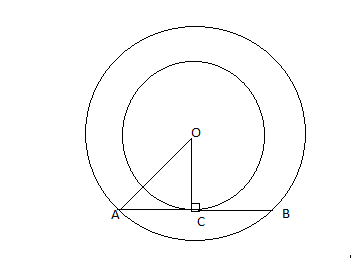Answer
419.7k+ views
Hint-For solving such a question we just need to know the basic and proof of geometry as a perpendicular from the centre on a chord bisects the chord.
Complete step by step answer:
Given,
Radii are a and b where a>b,
In $\Delta $AOC,
$O{A^2} = O{C^2} + A{C^2}$
$
A{C^2} = O{A^2} - O{C^2} \\
A{C^2} = {a^2} - {b^2} \\
AC = \sqrt {{a^2} - {b^2}} \\
$
We know that a perpendicular from centre of a circle to a chord bisects the chord, i.e. AB=2AC
AB=2$AC$=2$\sqrt {{a^2} - {b^2}} $
Here the answer is $2\sqrt {{a^2} - {b^2}} $
Note - For solving such a question we need to remember the proofs of geometry i.e. a perpendicular from centre of a circle to a chord bisect the chord. Proceeding like this you will get the right and answer to this problem.
Complete step by step answer:
Given,
Radii are a and b where a>b,
In $\Delta $AOC,
$O{A^2} = O{C^2} + A{C^2}$
$
A{C^2} = O{A^2} - O{C^2} \\
A{C^2} = {a^2} - {b^2} \\
AC = \sqrt {{a^2} - {b^2}} \\
$
We know that a perpendicular from centre of a circle to a chord bisects the chord, i.e. AB=2AC
AB=2$AC$=2$\sqrt {{a^2} - {b^2}} $
Here the answer is $2\sqrt {{a^2} - {b^2}} $
Note - For solving such a question we need to remember the proofs of geometry i.e. a perpendicular from centre of a circle to a chord bisect the chord. Proceeding like this you will get the right and answer to this problem.
Recently Updated Pages
Three beakers labelled as A B and C each containing 25 mL of water were taken A small amount of NaOH anhydrous CuSO4 and NaCl were added to the beakers A B and C respectively It was observed that there was an increase in the temperature of the solutions contained in beakers A and B whereas in case of beaker C the temperature of the solution falls Which one of the following statements isarecorrect i In beakers A and B exothermic process has occurred ii In beakers A and B endothermic process has occurred iii In beaker C exothermic process has occurred iv In beaker C endothermic process has occurred

The branch of science which deals with nature and natural class 10 physics CBSE

The Equation xxx + 2 is Satisfied when x is Equal to Class 10 Maths

Define absolute refractive index of a medium

Find out what do the algal bloom and redtides sign class 10 biology CBSE

Prove that the function fleft x right xn is continuous class 12 maths CBSE

Trending doubts
Difference between Prokaryotic cell and Eukaryotic class 11 biology CBSE

Fill the blanks with the suitable prepositions 1 The class 9 english CBSE

Write an application to the principal requesting five class 10 english CBSE

Difference Between Plant Cell and Animal Cell

a Tabulate the differences in the characteristics of class 12 chemistry CBSE

Change the following sentences into negative and interrogative class 10 english CBSE

What organs are located on the left side of your body class 11 biology CBSE

Discuss what these phrases mean to you A a yellow wood class 9 english CBSE

List some examples of Rabi and Kharif crops class 8 biology CBSE




